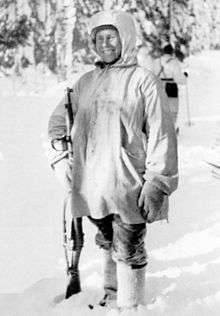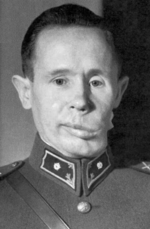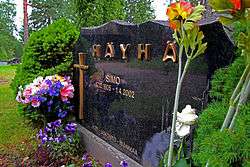Simo Häyhä
| Simo Häyhä | |
|---|---|
 Häyhä after being awarded the honorary rifle model 28. | |
| Nickname(s) | White Death |
| Born |
December 17, 1905 Rautjärvi, Viipuri Province, Finland, Russian Empire |
| Died |
April 1, 2002 (aged 96) Hamina, Finland |
| Allegiance |
|
| Years of service | 1925–1940 |
| Rank | Alikersantti (Corporal) during the Winter War, promoted to Vänrikki (Second Lieutenant) shortly afterward[1] |
| Unit | Infantry Regiment 34 |
| Battles/wars | Winter War |
| Awards |
Cross of Liberty, 3rd class and 4th class; Medal of Liberty, 1st class and 2nd class; Cross of Kollaa Battle[1] |
Simo "Simuna" Häyhä (Finnish pronunciation: [ˈsimɔ ˈhæy̯hæ]; December 17, 1905 – April 1, 2002), nicknamed "White Death" (Russian: Белая смерть, Belaya Smert; Finnish: valkoinen kuolema; Swedish: den vita döden) by the Red Army, was a Finnish marksman. Using a Finnish M/28-30 rifle (a Finnish variant of the Mosin–Nagant rifle) and the Suomi KP/-31 Submachine Gun, in the Winter War, he is reported as having killed 505 men, the highest recorded number of confirmed sniper kills in any major war.[2][3]
Early life
Häyhä was born in the municipality of Rautjärvi near the present-day border of Finland and Russia, and started his military service in 1925. Before entering combat, Häyhä was a farmer and hunter. At the age of 20, he joined the Finnish militia Suojeluskunta and succeeded with his marksman skills in shooting sports in Viipuri province. His home was reportedly full of trophies for marksmanship.[4]
Winter War service

During the Winter War (1939–1940) between Finland and the Soviet Union, Häyhä served as a sniper for the Finnish Army against the Red Army in the 6th Company of JR 34 during the Battle of Kollaa in temperatures between −40 °C (−40 °F) and −20 °C (−4 °F), dressed completely in white camouflage. Stalin’s purges of military experts caused chaos, and Soviet troops were not issued with white camouflage suits for most of the war, making them easily visible to snipers.[5] Häyhä has been credited with 505 sniper kills.[2][6] A daily account of the kills at Kollaa was made for the Finnish snipers. All of Häyhä's kills were accomplished in fewer than 100 days – an average of just over five kills per day – at a time of year with very few daylight hours.[7][8][9]
Häyhä used an M/28-30 with serial number 60974, because it suited his small frame (1.6 m (5 ft 3 in)). The rifle is a shorter, Finnish White Guard militia variant of the Mosin–Nagant rifle, known as "Pystykorva" (literally "Spitz", due to the front sight's resemblance to the head of a spitz-type dog) chambered in the Finnish Mosin–Nagant cartridge 7.62×53R. He preferred iron sights over telescopic sights as to present a smaller target for the enemy (a sniper must raise his head higher when using a telescopic sight), to increase accuracy (a telescopic sight's glass can fog up easily in cold weather), and to aid in concealment (sunlight glare in telescopic sight lenses can reveal a sniper's position). As well as these tactics, he frequently packed dense mounds of snow in front of his position to conceal himself, provide padding for his rifle and reduce the characteristic puff of snow stirred up by the muzzle blast. He was also known to keep snow in his mouth whilst sniping, to prevent steamy breaths giving away his position in the cold air.[10]
The Soviets' efforts to kill Häyhä included counter-snipers and artillery strikes, and on March 6, 1940, Häyhä was hit by an explosive bullet in his lower left jaw by a Red Army soldier, blowing off his lower left cheek.[11] He was picked up by fellow soldiers who said "half his face was missing", but he did not die, regaining consciousness on March 13, the day peace was declared. Shortly after the war, Häyhä was promoted from alikersantti (Corporal) to vänrikki (Second lieutenant) by Field Marshal Mannerheim.[12]
Later life

It took several years for Häyhä to recuperate from his wound. The bullet had crushed his jaw and blown off his left cheek. Nonetheless, he made a full recovery and became a successful moose hunter and dog breeder after World War II, and hunted with the Finnish President Urho Kekkonen.[10]
When asked in 1998 how he had become such a good shooter, Häyhä answered, "Practice." When asked if he regretted killing so many people, he said, "I only did my duty, and what I was told to do, as well as I could." Simo Häyhä spent his last years in Ruokolahti, a small municipality located in southeastern Finland, near the Russian border. Simo Häyhä died in a war veterans' nursing home in Hamina in 2002 at the age of 96,[12][13] and was buried in Ruokolahti.[14]
Cultural depictions
Simo Häyhä was the inspiration for "White Death," a song from the album Coat of Arms of Swedish power metal band Sabaton.
Further reading
| Wikimedia Commons has media related to Simo Häyhä. |
- Meeting A Legend: Simo Häyhä. Mosin–Nagant.net 2002
- P. Sarjanen, Valkoinen kuolema. ISBN 952-5170-05-5.
- Tapio A. M. Saarelainen, Sankarikorpraali Simo Häyhä. ISBN 952-5026-52-3. http://www.apali.fi
- Tapio A. M. Saarelainen, The Sniper: Simo Häyhä. ISBN 978-952-5026-74-0. http://www.apali.fi
- William R. Trotter, Frozen Hell: The Russo-Finnish Winter War of 1939/40, Algonquin Books of Chapel Hill, 2000. ISBN 978-0-945575-22-1.
- Adrian Gilbert, Tom C. McKenney, Dan Mills, Roger Moorhouse, Charles Sasser, Tim Newark, The Sniper Anthology: Snipers of the Second World War, Pelican Publishing Company, 2012. ISBN 978-1-455616-82-4.
References
- 1 2 Lappalainen, Jukka-Pekka (6 December 2001). "Kollaa kesti, niin myös Simo Häyhä" [The Kollaa held out, so did Simo Häyhä] (fee required). Helsingin Sanomat (in Finnish). Helsinki. Retrieved 19 February 2011.
- 1 2 Rayment, Sean (30 April 2006). "The long view". The Daily Telegraph. London. Retrieved 30 March 2009.
- ↑ Tapio A.M. Saarelainen: Sankarikorpraali Simo Hayha (2006)
- ↑ Gilbert, Adrian (1996). Sniper: The Skills, the Weapons, and the Experiences. St. Martin's Press. p. 88. ISBN 0-312-95766-1.
- ↑ [pp. 145–146 The Winter War: The Russo–Finnish War of 1939–40 by William R. Trotter, Workman Publishing Company, New York (Aurum Press, London), 2002, First published 1991 in the United States under the title A Frozen Hell: The Russo–Finnish Winter War of 1939–40]
- ↑ "Sotasankarit-äänestyksen voitti tarkka-ampuja Simo Häyhä". MTV3 (in Finnish). Retrieved 30 March 2009.
- ↑ Jowett, Philip S. (2006). Finland at War, 1939–45. Osprey Publishing. pp. 44–45. ISBN 978-1-84176-969-1.
- ↑ Pegler, Martin (2006). Out of Nowhere: A History of the Military Sniper. Osprey Publishing. p. 167. ISBN 978-1-84603-140-3.
- ↑ Farey, Pat; Spicer, Mark (5 May 2009). Sniping: An Illustrated History. Zenith Press. pp. 117–118. ISBN 978-0-7603-3717-2.
- 1 2 Stirling, Robert (20 December 2012). Special Forces Sniper Skills. Osprey Publishing. pp. 79–80. ISBN 978-1-78096-003-6.
- ↑ Saarelainen, Tapio (31 October 2016). The White Sniper: Simo Häyhä. Casemate. ISBN 9781612004297.
- 1 2 Feist, Paul (21 July 2012). "The Winter War and a Winter Warrior". The Redwood Stumper 2010: The Newsletter of the Redwood Gun Club, Arcata, CA. Arcata, CA: Redwood Gun Club. p. 36. ISBN 978-1-300-03973-0.
- ↑ Yle
- ↑ Simo "Simuna" Häyhä at Find a Grave